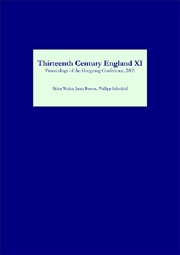Book contents
- Frontmatter
- Contents
- LIST OF ILLUSTRATIONS
- PREFACE
- CONTRIBUTORS
- ABBREVIATIONS
- ‘Adam of Bristol’ and Tales of Ritual Crucifixion in Medieval England
- Ethics and Office in England in the Thirteenth Century
- Some Aspects of the Royal Itinerary in the Twelfth Century
- The minority governments of Henry III, Henry (VII) and Louis IX compared
- Scottish Queenship in the Thirteenth Century
- Ethnicity, personal names, and the nature of Scottish Europeanization
- Power, Preaching and the Crusades in Pura Wallia c.1180–c.1280
- A Forgotten War: England and Navarre, 1243·4
- The Appointment of Cardinal-deacon Otto as Legate in Britain (1237)
- Matthew Paris and John Mansel
- The Burial of Noblewomen in Thirteenth-Century Shropshire
- Dynastic Conflict in thirteenth-century Laxton
- Absenteeism: The Chronology of a Concept
‘Adam of Bristol’ and Tales of Ritual Crucifixion in Medieval England
Published online by Cambridge University Press: 12 September 2012
- Frontmatter
- Contents
- LIST OF ILLUSTRATIONS
- PREFACE
- CONTRIBUTORS
- ABBREVIATIONS
- ‘Adam of Bristol’ and Tales of Ritual Crucifixion in Medieval England
- Ethics and Office in England in the Thirteenth Century
- Some Aspects of the Royal Itinerary in the Twelfth Century
- The minority governments of Henry III, Henry (VII) and Louis IX compared
- Scottish Queenship in the Thirteenth Century
- Ethnicity, personal names, and the nature of Scottish Europeanization
- Power, Preaching and the Crusades in Pura Wallia c.1180–c.1280
- A Forgotten War: England and Navarre, 1243·4
- The Appointment of Cardinal-deacon Otto as Legate in Britain (1237)
- Matthew Paris and John Mansel
- The Burial of Noblewomen in Thirteenth-Century Shropshire
- Dynastic Conflict in thirteenth-century Laxton
- Absenteeism: The Chronology of a Concept
Summary
Stories describing the ritual crucifixion of Christian children by Jews were widely told and commonly believed by Christians throughout medieval Europe from the middle of the twelfth until the end of the sixteenth century. Such stories seem to have had a particular appeal in medieval England, however, for reasons that remain only partially understood. Between 1144, when the first allegation of ritual crucifixion was made against the Jews of Norwich, and 1290, when the entire Jewish population of England was expelled from the kingdom, at least a dozen allegations that Jews had murdered a Christian child were recorded by English chroniclers, hagiographers, or royal justices. Not all these cases resulted in a saint's cult developing around the body of the murdered child. Although devotional shrines to the alleged victims of ritual crucifixion were successfully established at Norwich by c. 1150, Bury St Edmunds in 1181, and Lincoln in 1255, similar efforts at Gloucester in 1167, at London in 1244, and at Northampton in 1279 seem to have ended in failure. The expulsion of 1290 brought an end to the establishment of new such cults, at least in England. But the shrines at Norwich, Bury and Lincoln continued to attract pilgrims until the end of the Middle Ages, and tales of ritual crucifixion continued to be told, not only by Geoffrey Chaucer in his Prioress's Tale, but also by John Lydgate and a number of other late medieval English authors.
- Type
- Chapter
- Information
- Thirteenth Century England XIProceedings of the Gregynog Conference, 2005, pp. 1 - 15Publisher: Boydell & BrewerPrint publication year: 2007



